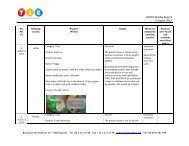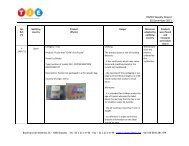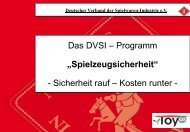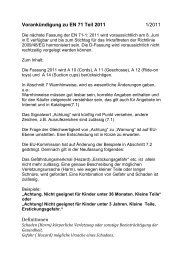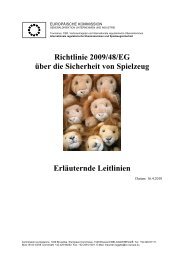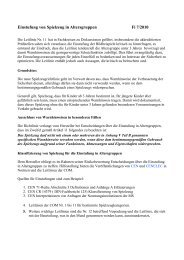You also want an ePaper? Increase the reach of your titles
YUMPU automatically turns print PDFs into web optimized ePapers that Google loves.
<strong>EN</strong> <strong>71</strong>-1:<strong>2005+</strong><strong>A8</strong>:2009 (E)<br />
Template E, as defined -in Figure 31. (see 8.32, small balls and suction cups test), addresses balls<br />
capable of entering and blocking the airways at the back of the mouth and upper throat. Ball-shaped objects<br />
trapped behind the ridge of the hard palate can be very difficult to remove due to a reflex that causes<br />
muscular constriction of the throat. Therefore, ventilation holes are not considered to be an appropriate way of<br />
avoiding the hazards related to small balls since a ball can be trapped in any position and therefore many<br />
large holes in all directions would be needed.<br />
Unlike small parts which only present a hazard when they become detached, small balls present a choking<br />
hazard even when they are attached to a toy by a cord or similar, provided that the total length of the cord and<br />
part of the ball is such that the ball can block the airway at the back of the mouth and upper throat. This length<br />
has been defined as 30 mm since this is identical to the depth of templates A and B.<br />
A ball is considered to be “suspended freely” if it is attached to the end of a string regardless of whether the<br />
string is attached to the top of the ball or runs through a part of the ball -(see example in Figure 32).. A<br />
single ball attached to the lowest part of a loop of string attached to a toy (as in Figure A.1), is also covered by<br />
the requirements.<br />
88<br />
Figure A.1 – Ball attached to a toy by a loop<br />
Balls and other ball-shaped three-dimensional objects with minor diameters larger than 44,5 mm are seldom<br />
implicated in incidents since these objects are too large to become trapped behind the ridge of the hard palate.<br />
It is the shape of the ball rather than the intended use of the ball that presents the choking hazard.*<br />
A.49 Toy scooters (see 4.15.5)<br />
A body mass of 20 kg corresponds approximately to the average mass of a child of 5 years. A body mass of<br />
50 kg corresponds approximately to the average mass of a child of 14 years.<br />
The safety of scooters considered as sports equipment is covered by <strong>EN</strong> 14619.<br />
It should be noted that the standard for scooters used as sports equipment is applicable to scooters that weigh<br />
35 kg or more. Therefore there are two types of scooters for the weight group 35 kg to 50 kg – those<br />
classified as toy scooters and those classified as sporting goods.<br />
It has not been considered necessary to require brakes for toy scooters for very young children because they<br />
do not normally travel with great speed and are not considered able to operate a brake.



